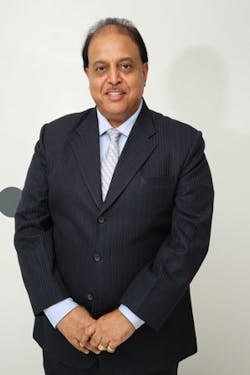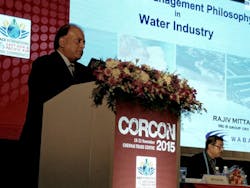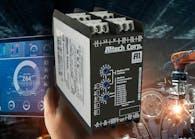VA Tech Wabag has been on an interesting journey, from European to Indian ownership. After successfully going public, Rajiv Mittal has bold ambitions to make the company a top three pure-play global water company and generate $1 billion in revenue by 2018. Tom Freyberg catches up with the CEO to find out how the company is progressing.
Water & Wastewater International magazine (WWi): You have set out ambitious plans to triple annual revenues to $1 billion by 2018 compared to $333 million in 2014. How is this progressing and is the company on track?
Rajiv Mittal, CEO and group chairman, VA Tech Wabag Group (RM): I believe we are. We had started from scratch about 19 years back: when we came back from Europe we started the water business for Wabag in India. We believe as Wabag evolves we are covering the total water business. Our markets are emerging markets and we are in the EPC (engineering, procurement and construction) and owners part of the business. We want to be a total lifecycle partner of our customer.
Water is very local business. It cannot be done centrally. You have to have a local presence. Today we have more than 12 multi domestic users which are running as local entities. By having that in Europe we are market leaders.
In countries like Turkey, Philippines, Saudi we have also taken the market leadership. Even Egypt, which is in turmoil, we are executing half a dozen projects. With this type of strategy and having a strong technology back up, as we have our own technologies, we believe we will be able to meet this $1 billion target.
WWi: Do you have any estimates on how well you did in 2015?
RM: I’m not allowed to say.
WWi: Can you at least reflect and say you’re on track to hit the $1 billion target by 2018?
RM: What we say is that we aim for 20% growth year on year. Our target over the next four years is to bigger than this 20% growth year on year.
WWi: Let’s talk about the Indian market. Reports suggest only a third of domestic market is treated. You have been reported to say that order intake has been pretty poor recently. Why is this, given the sheer need for treatment infrastructure?
RM: India is going to be a big market. Currently, water and wastewater infrastructure is not so existent here. Over the last three years the country went through an election and a change in government. As a result, there was a lack of projects being announced and the government also wanted to understand which party was going to get elected.
With the new government coming to power they wanted to change some of the systems, some of the policies, some of the way the programmes the past government was running, and this slowed down the projects. A fact finding mission was the undertaken, inviting committees, think tanks, various stakeholders and local bodies to say what is the best way to handle the water business in India.
The true value is not being charged for water in India. It’s still considered more a right. On Jan 6th 2016 our central cabinet approved, for the first time in India, proposals for using a hybrid EPC public-private model for the way wastewater systems are managed in India. I believe that over the last two to three years things have slowed but India is moving towards a sustainable model. As a group we are staying very bullish about our home market.
WWi: The Smart cities programme in India is getting a lot of attention. What does this mean for Wabag in terms of water project activity?
RM: Smart Cities is another flagship of this new government. They have already identified 100 smart cities. From this 100 smart cities, depending on the consultant initial report they are going to select 20 smart cities for the detailed implementation. One aim is to reduce non-revenue water, get all the water treated, ensure 24/7 water availability and to ensure non interrupted water supplies.
I think these things will tie in with Wabag’s vision to provide better life to the people and that’s one of our taglines: solutions for better life. I think this is where we can connect with people. We can be part of a consortium that brings in smart solutions, whether it’s power, monitoring, infrastructure and water.
We’re saying that smart cities should be moving towards water neutrality. What does being water neutral mean? They should not be dependent too much on water extraction. They use most of the used water and recycle it for various purposes, whether for domestic use, or industrial use. And only a small amount for potable uses should be extracted. We should make these smart cities as water neutral as possible.
WWi: India is developing its desalination market, particularly in Chennai. Is there the potential for more desalination in India, despite the domestic market being slow for new municipal projects?
RM: Personally, India is a water scarce country and some of the regions are water starved. So we have to look for alternative sources of water. India is fortunate to have a very long coastline, especially the coastal towns that have to depend on desalination as a source of water.
For the last decade, most of the industries - power plants, oil and gas - have been tapping into this seawater for their water requirements. Chennai was the first city, on a major scale, that used seawater to meet potable water requirements. I believe that potable water requirements will be met by desalination, especially in the areas where freshwater is not available.
WWi: So India could really be a big desalination market moving forward?
RM: With the oil prices, projects will slow down in the Middle East. India will become a stable alternative market for desalination.
WWi: Big statement. Let’s talk about China - why did Wabag pull out of China and why is this one country you’re leaving alone?
RM: It’s very simple. Markets where we cannot be a top three player in the country and we don’t see change in the future, we don’t want to be there. We don’t want to be in a country where we don’t have a dominance.
Even after 27 years of taking over, in China we couldn’t find a reason why we would be in the top EPC contractors in water. We tried to win EPC projects in China. However, up against the local companies with their experience and track record - we could not bring anything additional to beat them on price. It was purely on price and Wabag was not finding itself competitive on price. Even after 75 EPC projects in China those projects were all technology projects. It was purely a price game and we could not compete in this price game so that’s the reason we decided to pull out.
We still have references in China and want to remain as a technology partner for the large EPC companies. That is the Wabag model in the China market.
WWi: So, unless you can be in the top three EPC player in a country, you have no interest?
RM: Correct - that market will never ever be our target market. We could pick up one or two jobs but it won’t be our target market.
WWi: I applaud your ambition. From looking at your reports, about 75% of projects are provided on EPC compared to O&M. Do you see this changing?
RM: Our O&M (operation & maintenance) business used to be just 10% of our EPC business. Then we had a vision and strategy to be much more. We want to be lifecycle partners of our customers. By doing this we have a closer proximity to our customers.
That’s also one reason why O&M markets in terms of percentage are always bigger than the EPC markets. The risk tied to O&M is considerably lower than the EPC risk and also O&M brings in more predictability to the business. We are not into asset ownership - we are an asset life company. The only way to bring in more predictability into our numbers is to be in the O&M business. That’s why we started focusing on it.
Today we are at 25%. We are more or less where we want to be - maybe we want to add 5% to O&M so it’s 70/30, which will bring great balance between our risk and our margin.
WWi: So by having that 30% O&M baseline income, the remaining 70% lies in the design and construction of major facilities, as and when you win those contracts?
RM: Absolutely. We want our fixed cost to be taken care of by the O&M. The EPC business is very unpredictable and is very changeable business. So we don’t want to only depend on EPC to take care of our fixed costs. O&M should be able to take more of my fixed costs.
WWi: Tell me about the importance of the wastewater reuse market in Namibia and how do you plan to get a bigger presence in the Africa market?
RM: We need to look for alternate sources of water. After talking about desalination, second to us is used water and I’m using the word used water instead of wastewater because that is more positive.
In Namibia, 15 years ago we built a plant, which was inaugurated in 2002. This was municipal used water which we were using for potable purposes. In Windhoek, the Namibian government used 25% used water and blended it with 75% potable water from others sources, coming mainly from surface water and partly also groundwater mixed to the taps of the people.
They were smart to ensure that industrial water was not mixing with the municipal water. Only the municipal used water. The Namibian government gave us a contract to do a similar thing for industrial used water. Recycling for us is the future and it’s a big market.
WWi: In the water industry the bigger players have put their home nations on the map for international water expertise, whether its French powerhouses such as Suez or Veolia, or Hyflux from Singapore, Spain’s Acciona Agua, Abengoa etc. Is it your aim to have Wabag as India’s equivalent of these companies?
RM: I think we are already at that stage in the global area. People respect us and know us as capable EPC technology company in the water sector. Our ambition globally is to be a pure-play water company with total water management capability. One thing that Wabag differentiates is we are into total water management.
We would like to see ourselves comparable to the French, like Veolia and Suez. They are truly total water management companies and have a track record and experience in all the areas of water management. Today, we have three R&D centres - one of the largest is Switzerland close to Zurich, another in Vienna and the last here in Chennai. We have almost 100 patents.
WWi: The French giants you mentioned diversified into markets such as solid waste but you will be sticking to water?
RM: That’s right. That’s our focus and that’s where we want to be - a pure play water company. We don’t want to diversify into solid waste like Suez and Veolia. We want to focus on water and that’s where our strategy is very clear. We are no doubt India’s largest EPC water company. Our ambition is to become in the top three companies globally.
WWi: Finally, what’s the secret to being a successful entrepreneur in India?
RM: I think there’s a few things I would like to share. There is definitely my can-do attitude: I never take no as an answer. One thing that’s important to me - I can inspire people. I believe I lead the team from the front and become a role model and believe in people, which helps the team to deliver exceptional results. That trust and caring which I build with the team is important. In a business like ours we have two levers - one is technology and the other is human capital. If we can manage these two well, the company will succeed.
Tom Freyberg is the chief editor of WWi magazine. For more information on the article, please email: tomf@pennwell.com
West to East: A short history of VA Tech Wabag
VA TECH WABAG GmbH resulted from the merger in 1999 of the water technology segment of the VA TECHNOLOGIE Group with that of DEUTSCHE BABCOCK. However, the WABAG brand actually dates back to 1924, when Max Reder founded the WABAG Wasserfilter-Bau in Breslau. One of the roots of the current WABAG extends to the year 1868 and the founding of the Viennese company, Julius Overhoff, which was highly successful with its water treatment activities in the 1930s and in 1987, was integrated into the Austrian SGP AG. The emergence of VA TECH WABAG came in 1999. In October 2010, the company achieved a successful IPO in India of VA TECH WABAG Ltd.
More Water & WasteWater International Archives Issue Articles



